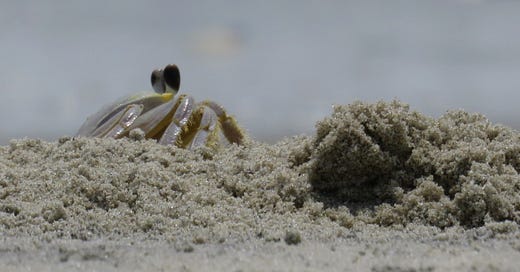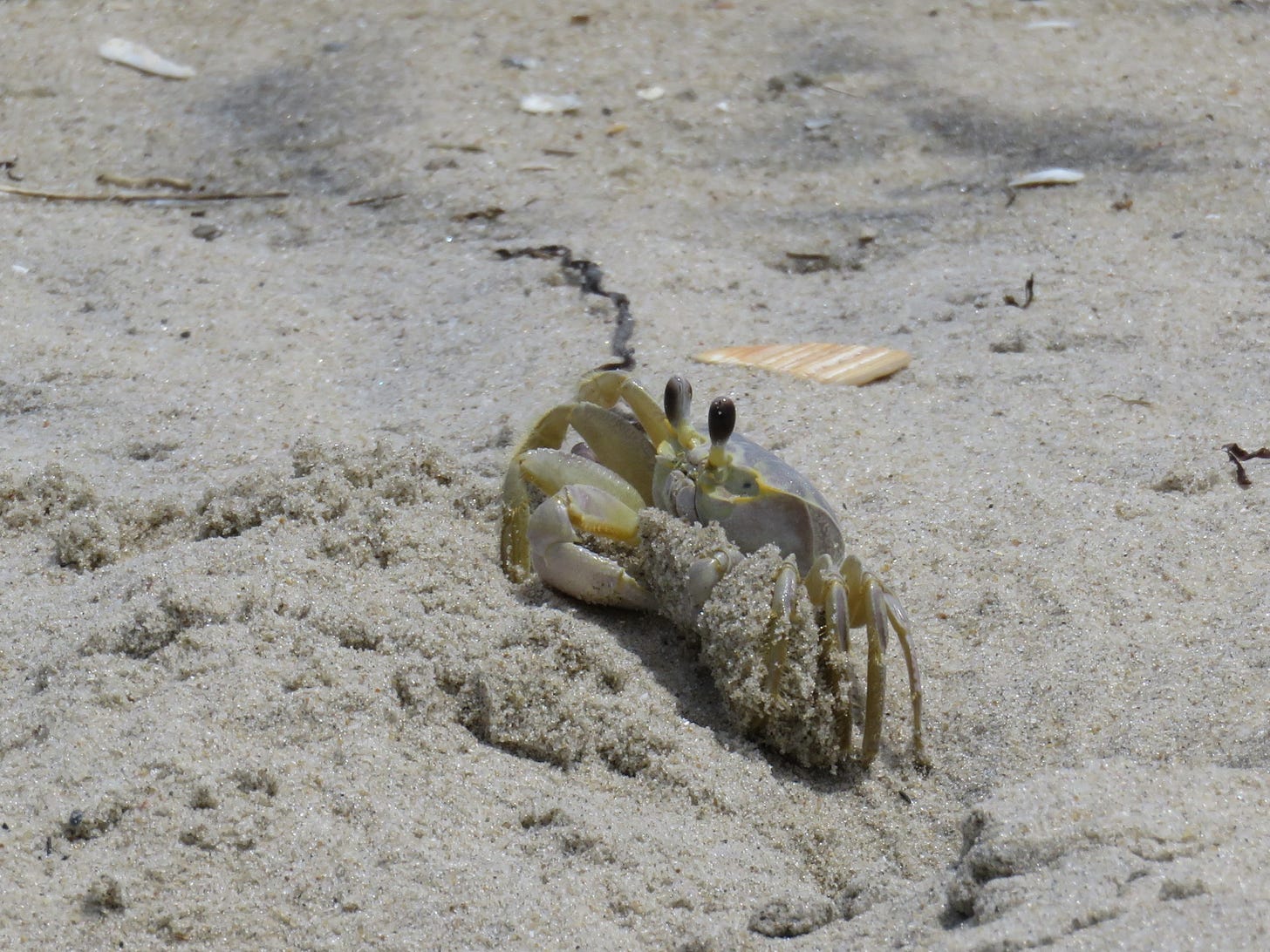I’m a keen observer of beaches. Having spent several years studying conchs on the beaches of South Carolina, I scan the sands with a detective’s eye. Is that bump the telltale sign of a whelk siphon? A periwinkle clam? Or just an air bubble in the sand? Details that wouldn’t concern a casual beachcomber often turn out to be subtle clues to some amazing natural phenomenon.
Walking along a beach in the remote Virginia barrier islands, I came across a jumble of disturbed sand pockmarked with holes and little scratchmarks. My first thought was that a dog had been digging in the sand, but there were no dogs on that beach – nor any other people for that matter. I then realized I was looking at a ghost town - literally, a village of ghost crab burrows and footprints.
I sat down nearby and waited quietly.
Scritch scritch scritch. Pffft.
The sound drew my attention. I turned my head to the left, then right. Nothing.
Scritch scritch. Pfft. A movement in my peripheral vision. I turn towards the sound.
Pfft, a small cloud of sand erupts from the beach. Remaining as still as possible, I watched a small pile of sand a few feet away from me.
Pfft, another small eruption from a hole behind the sand pile. There, a pair of dark eyes on stalks is looking back at me. We stare at each other for almost a minute. The eyes, attached to a ghost crab, disappear back down the hole. I wait for it to reappear, but it doesn’t. Aware of my existence now, the crab has decided to remain out of sight.
Ghost crabs are small, 2-3 inch wide occupants of many coastal beaches around the world. Their burrows are easily identified as a round hole next to a small mound of sand, surrounded by tracks made during foraging trips. The species common on Mid-Atlantic beaches is known to scientists as Ocypode quadrata (o-SIP-a-dee kwa-drata), meaning “swift-footed square-shell”, and is abundant from Rhode Island to Brazil. The common name ghost crab refers to their pale white or sandy color and habit of running across the beach at night.
As I watched, another crab came out of its burrow, carrying its detrital bolus football-style, tucked up against its shell; after a brief pause to determine if I was dangerous, it flung its handful (claw-full?) of sand up onto the growing pile of discarded diggings, then scurried back to safety. They are cleaning house, preparing their burrows for double occupancy, while waiting for a suitable mate to arrive.
Ghost crab burrows can be three to four feet deep and may be straight, or shaped like a V, L, or W. The crabs tend to stay in their burrows during the day, during which they may close the entrance to trap moisture. After dark, they come out to feed, then dig a new burrow at sunrise, rarely returning to the same burrow. Although they can stay out of water for extended periods of time, they eventually need to refresh the water in their gills by taking a dip in the surf (but not too long, or they’ll drown). They can also extract some moisture from the sand in their burrows.
Ghost crabs have one claw larger than the other, but unlike hermit crabs, which are almost always right-handed to conform with the snail shells they live in, they can be either left- or right-handed, and the proportion of each can vary among beaches. Ghost crabs defend their burrows by ritualized “fighting” with their claws, but tend to primarily fight like-handed crabs, whereas opposite handed crabs are at a disadvantage and tend to evade fights. Right and left-handed crabs may avoid each other by being active at different times of dawn and dusk.
So, I wondered, which hand does it use for cleaning the burrow – the larger or smaller claw? Keeping my eye on several burrows at a time, I waited for a crab to emerge. When it did, it came out of the burrow sideways, leading with the larger claw (probably for defense) and carrying its trash with the smaller claw. Most of the crabs I saw behaved similarly. I tried to keep track of how many were righties or lefties (south-claws?), but it was difficult to do without marking individual burrows. The final score was about an equal number of both types.
Crabs don’t hear well, but they can communicate. In a process called stridulation, the crab scrapes its claw across the base of the leg, causing it to vibrate. These and other low frequency vibrations are detected by motion sensors on the fourth leg. During mating season, crabs wander the beach and enter burrows looking for mates. Crabs in burrows may defend them by stridulating or rapping, repeated beating of the burrow walls with their claws. When crabs at the entrance to their burrow are approached by potential invaders, they may “sing and dance” by moving sideways, or around the approaching crabs, while rapping.
Most crabs can determine the sex of other crabs via odors when in water but doing this out of water requires visual cues. I saw several crabs attempt to enter the burrows of other crabs. Sometimes, the occupant came out to greet them, after which the visitor either left, or entered the burrow. Did the visitor know the gender of the burrow’s owner prior to their visit, or was it just guessing? I imagine them using a version of “Crab Tinder” – swipe the right claw and get invited inside, swipe the left one and – well, the rejected suitors must have been quite disappointed, in a crabby sort of way, whereas the invited guest was in for some crabby delights.
Ghost crabs are the largest invertebrates on most beaches, and thus an apex predator, feeding on mole crabs and small bivalves. They occasionally dine on eggs of sea turtles, but their impact is minor, so efforts to eliminate them from turtle nesting areas are misguided. Their major predators are birds, especially gulls, but they are also preyed on by raccoons and burrowing owls.
Many people enjoy “hunting” for ghost crabs on the beaches at night with flashlights. If spotted, the crab will freeze briefly like a deer in the headlights. But be respectful and try not to damage the crabs or their burrows. While not dangerous, they can give you a nasty pinch if cornered (ask me how I know). The best time to see them is during breeding season, from April to July, whereas ghost crabs tend to hibernate in their burrows from October to April.
Ghost crabs are important components of beach ecosystems and are considered to be ecological engineers, because their burrows aerate the soil and help recycle nutrients. In fact, numbers of burrows can be used as an indicator of beach disturbance by humans. Burrows are more abundant on beaches with wider dunes and more vegetation, and those with less human use. While ghost crab populations are not threatened, beach modifications due to development or bulldozing (raking) tend to destroy crab habitat and displace the crabs away from prime beach habitat, and towards the upper and lower limits of the beach. On heavily disturbed beaches, especially where driving is allowed, the numbers of crab burrows can be significantly reduced, and burrows tend to be narrower and simpler, indicating that the crabs are under stress.
On Assateague and Chincoteague Island beaches, ghost crabs are often overlooked by tourists, beachgoers, and fishermen. But they are still important ecological components of the beaches and need to be conserved. Reducing off-road vehicle (ORV) traffic on beaches, especially at night, would reduce vehicle-caused deaths, and help maintain crab populations and diversity of the beach ecosystem. Healthy beaches provide more support for fish and bird populations and are more enjoyable for human recreation as well. And isn’t that why we go there?
As for myself, I look forward to spending future sunny days watching the antics of my crusty little friends, and hoping their beaches remain crab-friendly for many years to come.





